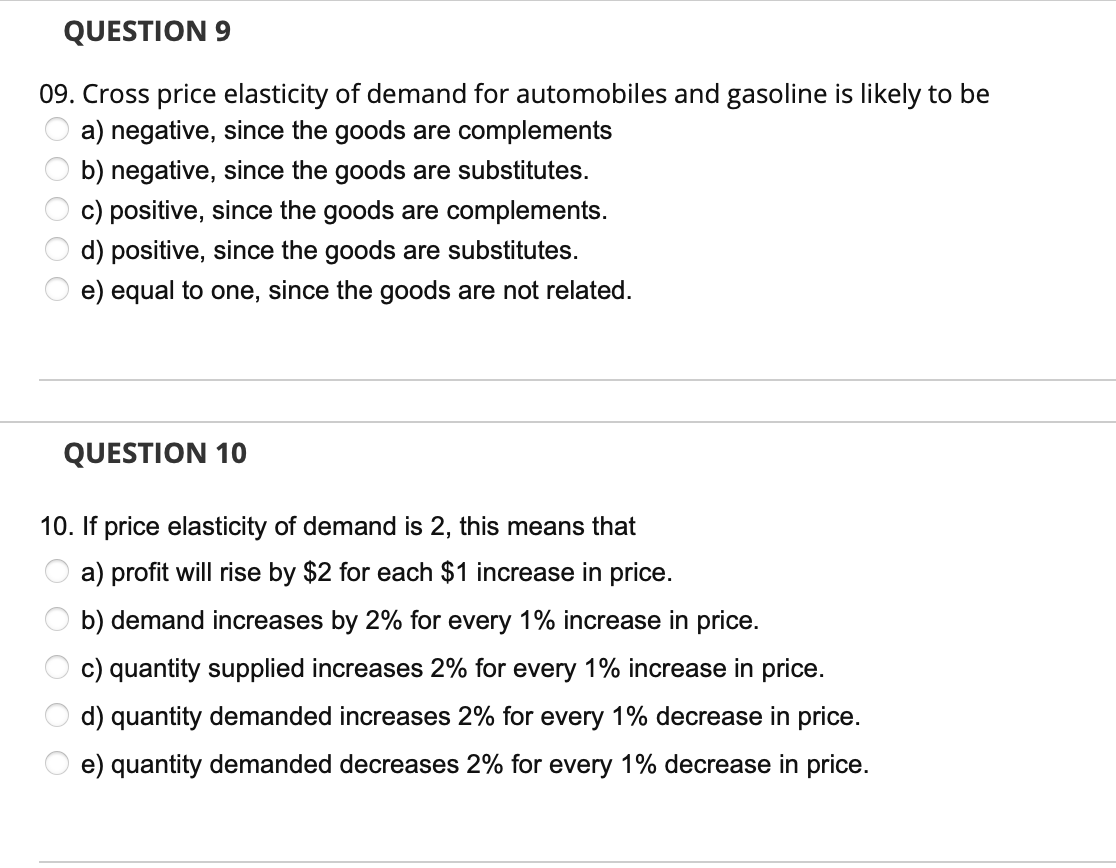QUESTION 9 09. Cross price elasticity of demand for automobiles and gasoline is likely to be a) negative, since the goods are complements b) negative, since the goods are substitutes. c) positive, since the goods are complements. d) positive, since the goods are substitutes. e) equal to one, since the goods are not related. 10000
QUESTION 9 09. Cross price elasticity of demand for automobiles and gasoline is likely to be a) negative, since the goods are complements b) negative, since the goods are substitutes. c) positive, since the goods are complements. d) positive, since the goods are substitutes. e) equal to one, since the goods are not related. 10000
Chapter5: Elasticity Of Demand And Supply
Section: Chapter Questions
Problem 1.1P: (Calculating Price Elasticity of Demand) Suppose that 50 units of a good are demanded at a price of...
Related questions
Question

Transcribed Image Text:QUESTION 9
09. Cross price elasticity of demand for automobiles and gasoline is likely to be
a) negative, since the goods are complements
b) negative, since the goods are substitutes.
c) positive, since the goods are complements.
d) positive, since the goods are substitutes.
e)
equal to one, since the goods are not related.
000 0
QUESTION 10
10. If price elasticity of demand is 2, this means that
a) profit will rise by $2 for each $1 increase in price.
b) demand increases by 2% for every 1% increase in price.
c) quantity supplied increases 2% for every 1% increase in price.
d) quantity demanded increases 2% for every 1% decrease in price.
e) quantity demanded decreases 2% for every 1% decrease in price.
O O O
Expert Solution
This question has been solved!
Explore an expertly crafted, step-by-step solution for a thorough understanding of key concepts.
Step by step
Solved in 2 steps

Knowledge Booster
Learn more about
Need a deep-dive on the concept behind this application? Look no further. Learn more about this topic, economics and related others by exploring similar questions and additional content below.Recommended textbooks for you


Microeconomics: Private and Public Choice (MindTa…
Economics
ISBN:
9781305506893
Author:
James D. Gwartney, Richard L. Stroup, Russell S. Sobel, David A. Macpherson
Publisher:
Cengage Learning

Economics: Private and Public Choice (MindTap Cou…
Economics
ISBN:
9781305506725
Author:
James D. Gwartney, Richard L. Stroup, Russell S. Sobel, David A. Macpherson
Publisher:
Cengage Learning


Microeconomics: Private and Public Choice (MindTa…
Economics
ISBN:
9781305506893
Author:
James D. Gwartney, Richard L. Stroup, Russell S. Sobel, David A. Macpherson
Publisher:
Cengage Learning

Economics: Private and Public Choice (MindTap Cou…
Economics
ISBN:
9781305506725
Author:
James D. Gwartney, Richard L. Stroup, Russell S. Sobel, David A. Macpherson
Publisher:
Cengage Learning


